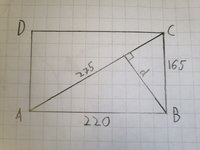You are using an out of date browser. It may not display this or other websites correctly.
You should upgrade or use an alternative browser.
You should upgrade or use an alternative browser.
Find the length of d
- Thread starter Akuseli
- Start date
D
Deleted member 4993
Guest
If I were to do this problem,This was some advanced math showed to our class by our teacher and I would like to get it solved if possible.
So the task is to find the length of d and all the picture has all the information that was given to us. There's no hurry.
ThanksView attachment 27270
I would first determine -
AB^2 + BC^2 = AC^2
And
What are the "similar" triangles in the given figure ?
Last edited by a moderator:
Find the area of the rectangle (length [MATH]\times[/MATH] breadth).
Half that, and you have got the area of the triangle ACB.
You know the area of this triangle is: half base [MATH]\times[/MATH] height
(base is 275, height d).
Hopefully you can now find d.
Half that, and you have got the area of the triangle ACB.
You know the area of this triangle is: half base [MATH]\times[/MATH] height
(base is 275, height d).
Hopefully you can now find d.
If I were to do this problem,
I would first determine -
AB^2 + BC^2 = AC^2
Yes, I suppose we should confirm that [MATH]\angle ABC[/MATH] is a right angle.Pythagoras theorem is applied here, and you are done.
as along as we are given the right angle of the length d, this can be solve in many waysYes, I suppose we should confirm that [MATH]\angle ABC[/MATH] is a right angle.
it can be solved as Khan said, similar triangles
It can be solved by your way lex, area and height
and finally and the easiest one is just Pythagorean
as along as we are given the right angle of the length d, this can be solve in many ways
it can be solved as Khan said, similar triangles
It can be solved by your way lex, area and height
and finally and the easiest one is just Pythagorean
You could do it using Pythagoras' Theorem, but it doesn't appear the easiest method:
[MATH]x^2+d^2=165^2[/MATH][MATH](275-x)^2+d^2=220^2[/MATH]
lolYou could do it using Pythagoras' Theorem, but it doesn't appear the easiest method:
[MATH]x^2+d^2=165^2[/MATH][MATH](275-x)^2+d^2=220^2[/MATH]
By easiest I meant you don't need to think too much, just use your strength in algebra by simplifying and solving the two equations
D
Deleted member 4993
Guest
In similar triangles, use your strength in geometry and solve one linear equationlol
By easiest I meant you don't need to think too much, just use your strength in algebra by simplifying and solving the two equations
Likewise with the areas.In similar triangles, use your strength in geometry and solve one linear equation
D
Deleted member 4993
Guest
Likewise with the areas.
No no .... with "areas" you have to solve two equations.... I win.....
pka
Elite Member
- Joined
- Jan 29, 2005
- Messages
- 11,978
Add the label \(E\) as the foot of the altitude from \(B\) so \(BE=d\). Now \(d\) is a mean proportional between \(AE~\&~CE\)This was some advanced math showed to our class by our teacher and I would like to get it solved if possible.
So the task is to find the length of d and all the picture has all the information that was given to us. There's no hurry.
No - there's only one equation to be solved! For the area of the triangle ABC:No no .... with "areas" you have to solve two equations.... I win.....
[MATH]\tfrac{1}{2}275d=\tfrac{1}{2}220\times165[/MATH]
Yours wins in beauty, mine I think in conceptual simplicity and simplicity of execution.
My reflection on the solutions!!
Conceptually I think area comes before similar triangles which comes before Pythagoras' Theorem.
In ease of execution I think the triangle area, similar triangles (have to be identified and correctly used), then the Pythagoras' Theorem solution.
In mathematical beauty similar triangles, then area/Pythagoras.
(Again special praise to you too, for pointing out that for our solutions the converse of Pythagoras' Theorem is needed to ensure [MATH]\angle ABC[/MATH] is a right-angle)!

